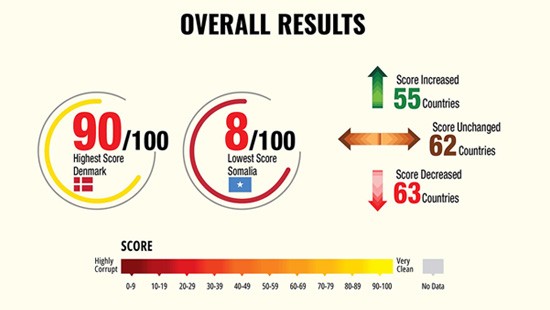Published: 14 January 2016
The successes of Bangladesh's readymade garment sector are phenomenal. Starting in 1980 with just 30 units, the sector now employs nearly four million workers, of which more than three million are women, through more than 4000 units. The sector not only earns more than 75% of the country's foreign exchange, but it's socio-economic impact in terms of empowering rural women, in particular, is a stunning success. While there is no turning back from this ongoing socio-economic transformation, the challenges of ensuring good governance in the sector are plenty. The tragic event at Rana Plaza on April 24, 2013 drew the world's attention to the prevailing conditions in Bangladesh's readymade garment sector. TI-Bangladesh's study in 2013 revealed lack of transparency and irregularities in the sector’s structure.
The government, with support from other stakeholders, including coalitions of both European, American and Canadian textile companies, took several initiatives to improve the overall conditions of the sector.
We are habituated to blaming our factory owners, exporters and government employees. But buyers, who are buying and making profits, are no less responsible for irregularities – Iftekharuzzaman
The last two year's positive developments included, among others, the formation of law, streamlining the safety and security standards, providing salaries as per wage board in 95% factories, issuance of identity cards by compliant factories, and Bangladesh Garment Manufacturers and Exporters Association (BGMEA)’s ‘Center of Excellence’ initiative to enhance workers’ awareness on fire safety, and surveys on around 67% factories to ensure fire, electrical and structural safeties by Accord and Alliance.Against this background, a joint TI-Bangladesh and TI-Germany study identified 16 real-life solicitation scenarios ranging from demands of extortion, fraud and falsification in Bangladesh's garment supply chain's three phases: bidding, production and delivery.


Here is a real-life scenario how the compliance auditor is bribed to collect 'compliance certificate' to satisfy the buyer's requirement:
A third party auditor has been appointed to audit a factory, which is under a contract to produce garments for a European buyer. The auditor pays a sudden visit to the factory, and due to unawareness of the visit, it has not been possible for the factory officials to disguise the shortcomings of some of the compliance issues. It is found that the factory is not compliant and many things need to be fixed. When the audit is complete, the owner of the factory requests the auditor to sit in his office room, and he offers the auditor some money for making the report positive and showing that the factory is compliant.
Here is another example how malpractices happen in the production phase when minimum wage, work hour, labor rights by a production unit are violated:
A large North American brand has recently granted a contract to a Bangladeshi garments manufacturer for the delivery of one million pieces of readymade shirts. The company sends an associate/ quality inspector on a surprise visit to the factory where s/he finds that the factory has been using children as young as 12 years for sewing shirt collars. During the visit a worker collapses in front of her. When he regains his sense, s/he makes a companion translate and gets the information that some of the workers like him are made to work 20 hours a day. It is also revealed that the factory does not ensure the workers’ minimum wage, nor it pays on time. It has also decreased the basic salary of workers of different grades. However, the factory prepares 2/3 sets of payroll record and hides the actual working hours. Moreover, it presents fictitious labor accounts including forged working hours and age of the workers. The quality inspector takes notes and before leaving s/he is asked to meet the owner in private for tea in his office. He then asks the quality inspector how much he has to pay to make her “overlook” the violations of labor laws and manipulated data.
Here is another example how buyers' unnecessary demand generates awkward
situation creating scopes for malpractices during the production phase:
A readymade garment factory situated near the Capital signs a contract with an American buyer to produce 20 thousand denim trousers. The buyer gives the design and requirements of their accessories for the product. The PU then collects all the accessories as per requirement and starts the production. But during the production period the buyer changes the design several times in the name of changing trends in fashion, which creates extra pressure on the PU to finish the production. The buyer does not agree to give extra time which adds pressure on the PU to meet the deadline. The factory is compelled to have the labor work extra hours. Moreover, the buyer asks that if the PU is not able to meet the time limit, it has to ensure air shipment at its own cost and threatens to cancel the work order. Even though according to the business deal between the factory and the buyer, some commercial costs were to be borne by the buyer, it refused to take over any extra cost for air shipment. It is quite sure that after maintaining all these requirements, the supplier will not be able to pay the labor neither in full nor in time. He feels being forced into illegal actions like violating labor laws and bribing the auditor.
And finally, another example during the supply phase when buyer’s fake claims during port inspection with an aim to blackmail the PU for giving a discount:
Recently a PU has produced 20,000 sweaters for a German buyer. In the production period it has maintained all requirements of the buyer along with compliance issues. The product has also been checked by a third party auditor selected by buyer. After completion of production, the factory has sent the products to port for shipment at its own cost. But in the port an inspection has been held by a buyer representative though there is no representative from the PU. The buyer representative claims that there are many broken and torn cartons and the packing is not accurate. Then the buyer threatens to cancel the order and send back the entire shipment to the factory’s warehouse.
After a while, the buyer calls the factory again and gives an option that if it gives him 20% discount on the products he will accept the entire shipment.
Releasing the report: UNDRESS CORRUPTION - How to Prevent Corruption in The Readymade Garment Sector: Scenarios from Bangladesh in Dhaka through a press conference on 14 January, TI-Bangladesh's Executive Director Dr. Iftekharuzzaman said: ""We are habituated to blaming our factory owners, exporters and government employees. But buyers, who are buying and making profits, are no less responsible for irregularities." Some buyers use their business and financial power and sometimes hold local factories hostage by placing orders to non-compliant factories to buy products at low prices, Dr. Zaman observed during the press conference.
The study reveals thatirregularities along the entire RMG supply chain have become a defacto rule. Violations of existing labor and safety laws are being “overlooked” through bribes which is also used to hide deficiencies of quality and quantity and non-compliance with buyers’ Codes of Conduct. In this atmosphere of failing governance and accountability of stakeholders, extortion is an additional “tool” used to maximize profit.
TI-Bangladesh urged the Government of Bangladesh to play a greater role in supervising and monitoring the sector and allocate additional resources. It also urged ensuring proper implementation of laws especially labor laws and rules. TI-Bangladesh also suggested that BGMEA, as the leading business association of the RMG sector, should guide its members to ensure integrity by strengthening its monitoring and supervision in terms of protecting the rights of its members that face challenges from the buyers.
TI-Bangladesh also suggested that a valid audit mechanism should be established by the buyers/ customers including regular internal audit on ethics and fair dealings and effective feedback procedure (factory) on each audit should be carried out by the top management of the buyers/customers.
The entire set of recommendations for all stakeholders can be found here







